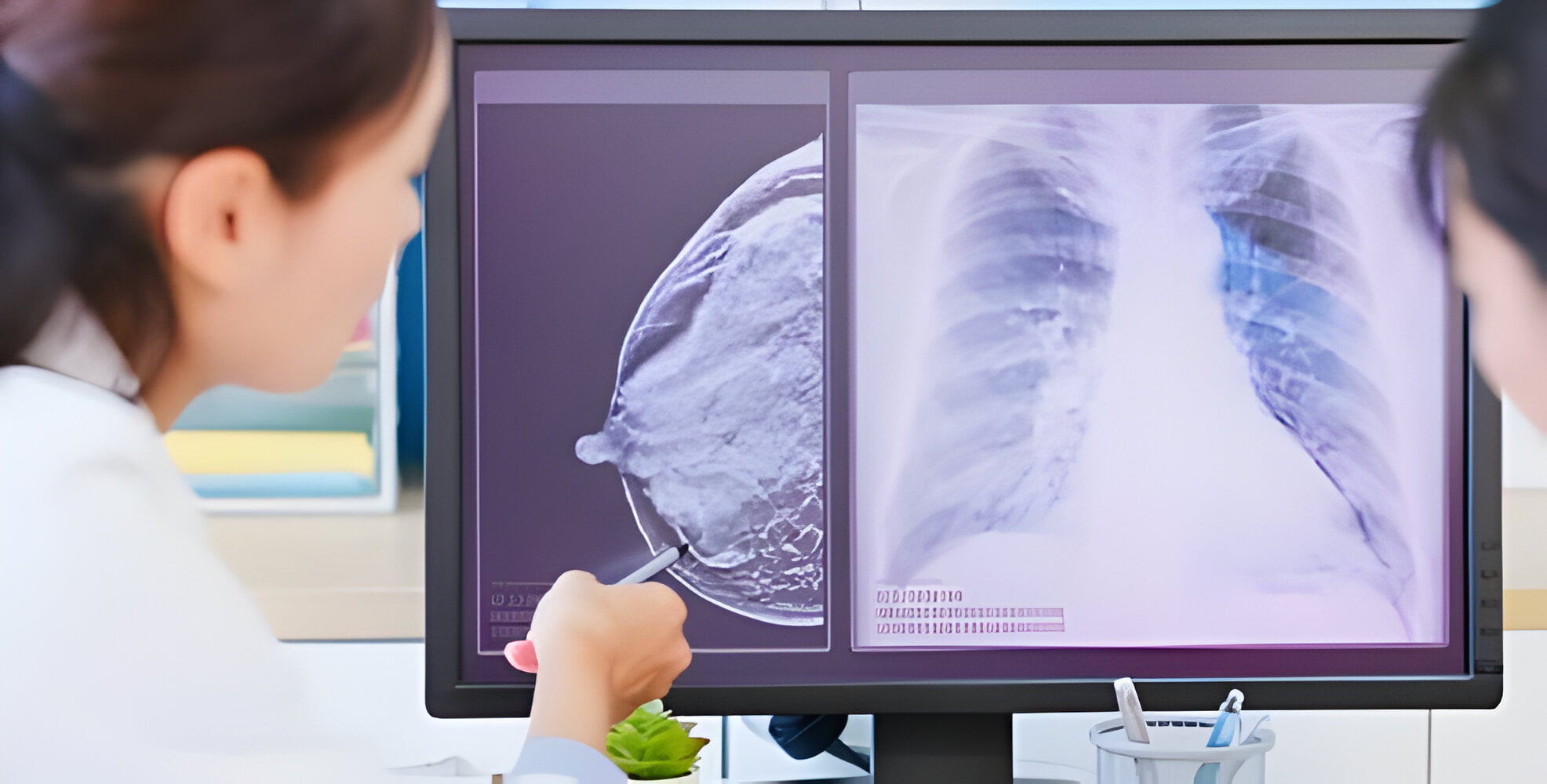Breast Cancer
Join us in the fight against breast cancer. Learn about prevention, early detection, and the latest advancements in treatment. Together, we can make a difference—one step at a time.
Take Charge of Your Health Today



Overview
- Breast cancer is a disease where abnormal breast cells grow uncontrollably and form tumors.
- It can start in the milk ducts or milk-producing lobules of the breast.
- Early-stage breast cancer (in situ) is not life-threatening, but invasive cancers can spread and become fatal.
- Treatment options include surgery, radiation therapy, and medications.
Breast Cancer Types
- Ductal Carcinoma In Situ (DCIS):
- Non-invasive cancer confined to the milk ducts.
- Early detection is crucial for preventing progression.
- Invasive Ductal Carcinoma (IDC):
- Most common type of invasive breast cancer.
- Starts in the milk ducts and spreads to nearby tissues.
- Invasive Lobular Carcinoma (ILC):
- Begins in the milk-producing lobules.
- May not form a distinct lump, making it harder to detect.




Breast Cancer Symptoms
Recognizing the signs of breast cancer is essential. Look out for:
- Breast lump or thickened area.
- Changes in nipple appearance: Flattening or inward turning.
- Skin color changes: Pink/red (white skin) or darker (brown/Black skin).
- Breast size, shape, or appearance changes.
- Skin dimpling or orange peel texture.
- Peeling, scaling, or flaking skin.
- Redness or pitting of breast skin.
Causes and Risk Factors
Understanding the factors that contribute to breast cancer:
- Genetic mutations (e.g., BRCA1, BRCA2).
- Hormonal changes.
- Age (risk increases with age).
- Family history.
- Lifestyle factors: Alcohol, obesity, radiation exposure.




Diagnosis
Early detection improves outcomes. Diagnostic methods include:
- Physical exam: Check for lumps, skin changes, and nipple abnormalities.
- Imaging tests:
- Mammogram: X-ray of breast tissue.
- Ultrasound: Sound waves to detect lumps.
- MRI: Detailed breast images.
- Biopsy: Removing tissue for lab testing.
Treatments
Tailored treatment plans based on cancer stage:
- Surgery:
- Lumpectomy: Remove tumor and surrounding tissue.
- Mastectomy: Removal of entire breast tissue.
- Breast reconstruction.
- Medications:
- Chemotherapy: Reduce mass size and prevent spread.
- Hormone therapy: Regulate hormone-sensitive cancer cells.
- Radiation therapy: Destroy cancer cells.
- Targeted therapies (if applicable).


Do’s
- Stay informed about breast health.
- Seek medical attention for any changes.
- Follow recommended screenings.
Don’t
- Ignore symptoms.
- Delay seeking help.
- Disregard preventive measures.
Testimonials
Our patient Most Valuable Words
EXCELLENT![Google]() Based on 152 reviews
Based on 152 reviews![Google]()
![Google]()
![Soni Agrawal]() Soni Agrawal01/11/2024
Soni Agrawal01/11/2024![Google]() One of the most knowledgeable cancer care doctor in hyderabad. Dr. Bharat offered best cancer treatment and with lot of facilities and very budget friendly treatment plans. He is very caring and has multiple options to cure cancer completely
One of the most knowledgeable cancer care doctor in hyderabad. Dr. Bharat offered best cancer treatment and with lot of facilities and very budget friendly treatment plans. He is very caring and has multiple options to cure cancer completely![Google]()
![radhika cherukuri]() radhika cherukuri28/10/2024
radhika cherukuri28/10/2024![Google]() Staff is very friendly, response is very quick ,overall good experience.
Staff is very friendly, response is very quick ,overall good experience.![Google]()
![GORLI BHAVYA]() GORLI BHAVYA08/10/2024
GORLI BHAVYA08/10/2024![Google]() Experienced doctors with good treatment
Experienced doctors with good treatment![Google]()
![Babu Rao kadali]() Babu Rao kadali04/10/2024
Babu Rao kadali04/10/2024![Google]() It is a great opportunity to share my experiences with Dr. Bharath Patodiya of Pi Cancer care center of Gachibowli. Actually when my wife Baby Kumari Kadali is suffering with breast cancer, I searched in Google for best treatment for breast cancer and came across the Pi cancer care center then approched Dr. BHARATH PATODIYA. We know first impressions is best impression. The same feeling I got while we discuss with him about my wife's treatment. We had fully satisfied with the way he explained about the method and process of treatment. He had drawn a chart of process of treatment of chemotherapy showing stages of treatment and period of treatment and estimation of cost for the treatment whi h is very reasonable. With out any second thought we decided to get the treatment of chemotherapy through the Pi Cancer Center under the Bharath Patodiyas supervision. Now Six months treatment over. Total eight chemos are over. Today is the last chemo . The greatest factor is he able to mimise the side effects during the process of chemotherapy. My wife suffered but with minimum side effects. Now she is perfectly all right. This is all because of method and process of Bharath Patodiyas treatment. My family always Thankful to the Bharath Patodiya and Pi Cancer care center. Thank you very much sir.. With great respect and regards. Baburao Kadali.
It is a great opportunity to share my experiences with Dr. Bharath Patodiya of Pi Cancer care center of Gachibowli. Actually when my wife Baby Kumari Kadali is suffering with breast cancer, I searched in Google for best treatment for breast cancer and came across the Pi cancer care center then approched Dr. BHARATH PATODIYA. We know first impressions is best impression. The same feeling I got while we discuss with him about my wife's treatment. We had fully satisfied with the way he explained about the method and process of treatment. He had drawn a chart of process of treatment of chemotherapy showing stages of treatment and period of treatment and estimation of cost for the treatment whi h is very reasonable. With out any second thought we decided to get the treatment of chemotherapy through the Pi Cancer Center under the Bharath Patodiyas supervision. Now Six months treatment over. Total eight chemos are over. Today is the last chemo . The greatest factor is he able to mimise the side effects during the process of chemotherapy. My wife suffered but with minimum side effects. Now she is perfectly all right. This is all because of method and process of Bharath Patodiyas treatment. My family always Thankful to the Bharath Patodiya and Pi Cancer care center. Thank you very much sir.. With great respect and regards. Baburao Kadali.![Google]()
![Krishna Prasanna]() Krishna Prasanna28/09/2024
Krishna Prasanna28/09/2024![Google]() Overall the experience is good.
Overall the experience is good.![Google]()
![Keerthi Devi]() Keerthi Devi13/09/2024
Keerthi Devi13/09/2024![Google]() The sisters at the hospital provided exceptional care, ensuring every patient felt comforted and well-looked after during their stay. Special mention to Mrs.Anitha from Nursing Dept.
The sisters at the hospital provided exceptional care, ensuring every patient felt comforted and well-looked after during their stay. Special mention to Mrs.Anitha from Nursing Dept.![Google]()
![Sayagni Sadhukhan]() Sayagni Sadhukhan05/09/2024
Sayagni Sadhukhan05/09/2024![Google]() Great behaviour
Great behaviour![Google]()
![Badam Vishnu Vardhan Reddy]() Badam Vishnu Vardhan Reddy30/08/2024
Badam Vishnu Vardhan Reddy30/08/2024![Google]() Nice hospital and good stuff everyone good
Nice hospital and good stuff everyone good
